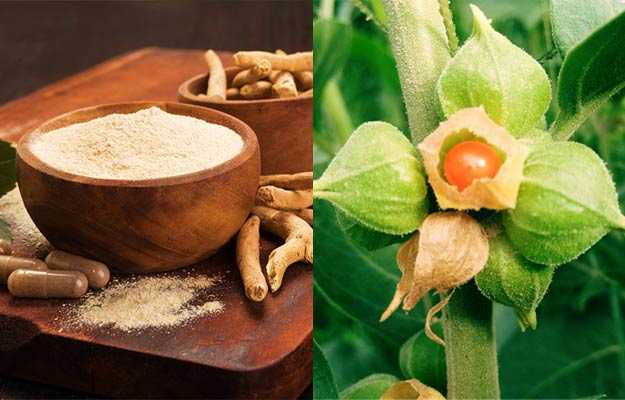What is Ashwagandha?
If you take ayurvedic medicines or believe in alternative medicines, chances are, you might have heard of ashwagandha many times. And why not? Ashwagandha is one of the most important ayurvedic herbs. The presence and usage of ashwagandha dates back to thousands of years according to Atharvaveda. The Indian traditional system of medicine often refers to it as a “magical herb” or adaptogen (anti-stress agent) because it is one of the most commonly used herbs to relieve stress-related symptoms and anxiety disorders.
The name ashwagandha comes from the word ashwa meaning horse and gandha meaning smell. Additionally translation literally comes from ashwagandha's roots that have a distinctive smell of the urine or sweat of a horse. And also ayurvedic researchers believe that ashwagandha, when consumed, provides virility (strength and sexual power) such as of that of the horse
Some basic facts on ashwagandha:
- Botanical name: Withania somnifera
- Family: Solanaceae (Nightshade family)
- Sanskrit names: Ashwagandha, Varahakarni (leaves resemble pig ears), Kamarupini.
- Common names: Winter cherry, Indian ginseng, Poison gooseberry.
- Parts used: Mostly Roots and Leaves but flowers and seeds are also said to be used
- Native region and geographical distribution: Ashwagandha is native to most of the drier parts of India (Madhya Pradesh and Rajasthan mainly), Nepal, Africa and the Middle East but it has also been introduced in the USA.
- How to use Ashwagandha and Ashwagandha Powder
- How does Ashwagandha work
-
Health Benefits and Uses of Ashwagandha
- Ashwagandha for a restful sleep
- Ashwagandha benefits for men
- Ashwagandha benefits for women
- Ashwagandha for hair
- Ashwagandha benefits for skin
- Ashwagandha in snake bites
- Ashwagandha for adrenal fatigue
- Ashwagandha for neurological diseases
- Ashwagandha for a healthy heart
- Ashwagandha increases thyroid functions
- Ashwagandha for improving sexual health
- Ashwagandha helps heal wounds
- Ashwagandha for a strong immune system
- Ashwagandha as an anti-arthritic
- Ashwagandha for diabetes
- Ashwagandha for mental health
- Ashwagandha Dosage
- Side effects of Ashwagandha
How to use Ashwagandha and Ashwagandha Powder
The root of Ashwagandha has been classically used, for many conditions such as insomnia, tumour, tuberculosis, asthma, leucoderma, bronchitis, fibromyalgia, adrenal fatigue. However, this herb is more commonly used as a general tonic, to improve physical health and mental health which is also called as a rasayana in ayurveda. According to some researchers, consuming ashwagandha is one of the best ways to improve your health as it is a known nutritional tonic that provides so many health benefits right out of your garden.
Ashwagandha is most commonly used as a powder or in the form of a tea. It can also be mixed with milk, ghee or honey for consumption. Ashwagandha tincture (alcoholic extract of the herb) and capsules have become more popular these days because these are easier to take and work faster.
It is also available in the form of syrups, topical creams, and pastes in the market.
Read more: Which is better ghee or butter?
How does Ashwagandha work
Ashwagandha has a number of “actions”. Action is a term used in herbology to explain the ways a herb or plant can act on the body. There are various terms to define the specific actions of a herb and the exact way a herb can function for the overall well being of a body. Here is a list of the most sought-after uses of ashwagandha as a herb:
- It is used to relieve stress and anxiety as it is a known adaptogen.
- It helps in rejuvenating the body and improves physical and mental health.
- According to some recent researchers, ashwagandha has found to have some anticancer properties. Work is still going on to determine the possible uses of this herb in the treatment of cancer.
- A research conducted by Indian scientists claim that ashwagandha is effective in reducing joint pains, especially in people with rheumatoid arthritis.
- Studies suggest that consuming ashwagandha can help improve libido and sexual health. Read more: How to improve libido
- As a diuretic, It helps get rid of excess fluid and salts from the body.
- It is good for cleansing skin and avoid early signs of aging.
- In a study, it has been found to increase the sperm count in males. Read more: how to increase sperm count
- Energetically, ashwagandha has a warming effect on the body. In ayurveda, it is known to increase pitta.
So what is pitta?
Ayurveda mentions three “doshas” or energetic regulators in the body that need to be in balance for the person to be in good health. These are:
- Vata - Deals with movement in the body and the nervous system activities.
- Pitta - Deals with metabolism in the body
- Kapha - Deals with the fluid balance of the body.
Health Benefits and Uses of Ashwagandha
In spite of being famous as a stress buster, ashwagandha has a wide variety of uses. Let us explore some ways that this herb is commonly used for promoting good health.
- Promotes mental-health: Ashwagandha is a well-known adaptogen. It has been found to reduce stress, depression and anxiety and prevent stress-related conditions such as high blood pressure and diabetes.
- Helps manage diabetes: Ashwagandha is an excellent anti-diabetic as suggested by research studies. It increases insulin levels and helps manage blood sugar levels in both healthy and diabetic individuals.
- Reduces arthritis symptoms: Being an effective anti-inflammatory, ashwagandha is useful for reducing arthritic pain and swelling. It also balances pitta, which is considered to be the cause of arthritis in ayurvedic medicine.
- Stimulates immune system: Research evidence indicates that ashwagandha is an excellent immunostimulator. It increases the ability of your immune system to fight against infections.
- Promotes wound healing: Oral administration of ashwagandha is suggested to speed up wound healing process in preclinical settings. However, human-based studies are still needed to confirm this benefit.
- Provides a restful sleep: By calming down stress and anxiety, ashwagandha helps your brain calm down enough to sleep soundly.
- Improves sexual health: Ashwagandha is known to increase libido in men and women. Studies suggest that it helps improve psychogenic erectile dysfunction and sperm count in men.
- Increases thyroid function: Ashwagandha has been found to increase T4 levels in body and help alleviate hypothyroidism. Though more studies are needed to confirm its safety for human use.
- Improves heart health: Ashwagandha gives all-round protection to your heart by strengthening heart muscles, preventing clot formation and reducing stress on the heart. It also reduces cholesterol, a major risk factor for heart disease.
- Preserves brain health: Studies indicate that ashwagandha slows down the neurological damage caused due to Parkinson's and Alzheimer's. However, the mechanism is currently unknown.
- Combats adrenal fatigue: As an adaptogenic herb, ashwagandha calms your mind, which, in turn, reduces cortisol levels (stress hormone) in your body. This leading to lesser pressure on kidneys and hence low adrenal fatigue.
- Act as an anti-venom for snake bites: Studies suggest that a topical application of ashwagandha neutralises snake venom and prevents its spread in the body. No wonder it is a traditional anti-venom herb.
- Beneficial for skin: As a rich source of antioxidants, ashwagandha is the perfect anti-ageing herb. It delays the first signs of ageing and also protects against dry skin and keratosis.
- Excellent hair tonic: Ashwagandha provides nutrition to hair, which assists in hair fall prevention and promoting longer and shinier hair. As an antioxidant, it delays premature hair greying and hair loss.
- Reduces menopausal symptoms: The tonic and anti-stress properties of ashwagandha make it an excellent option for menopausal women. It reduces stress, anxiety and balances hormones, providing respite from menopause symptoms.
- Boosts fertility in men: Research studies demonstrate the fertility boosting properties of ashwagandha. Not only does it increase sperm count and testosterone levels but also it improves sexual vigour and performance.
"Revitalize your sexual wellness with our Ashwagandha supplement. Known to support libido and vitality naturally. Elevate your intimate experiences. Order now for a more fulfilling sexual life."
Ashwagandha for a restful sleep
Researchers hint that, while it is not a strong sedative itself, but it helps in reducing stress, anxiety, calming down and induces good sleep.
Read more: How to overcome insomnia and sleep better
"Sleep support aid available! Enhance sleep quality naturally. Wake up refreshed and rejuvenated. Order now for a restful night's sleep!"
Ashwagandha benefits for men
Ashwagandha is one of the top herbs that are used for boosting fertility in men. Studies have shown that regular consumption of ashwagandha not only increases the sex drive in men but it is also effective in increasing the total sperm count and testosterone levels. The revitalizing benefits of ashwagandha also come into play when it comes to boosting the sexual health of men, as it provides more strength and virility, thereby improving their sexual performance.
Read more: Men's sexual problems and solutions
"Premium Ashwagandha available for purchase. Harness its stress-relief properties and overall wellness benefits. Order now and experience its natural goodness!"
Ashwagandha benefits for women
Studies suggest that ashwagandha is very effective in balancing the hormones and decreasing the menopausal symptoms like anxiety, irritation, and stress in women. As a tonic, consumption of ashwagandha can help you in reducing several diet-related deficiencies while it flushes out the toxins from the body in the form of a diuretic. The lesser the toxins in the body, the better your bodily functions would be. Researches have also shown that ashwagandha has a potent effect in increasing the sex drive in women. It does so by increasing blood circulation and decreasing stress in the body.
Read more: Female hormones imbalance symptoms
Ashwagandha for hair
The antioxidant and nutritive effects of ashwagandha make it an excellent tonic for hair. Ashwagandha nourishes hair follicles and strengthens the hair. Regular consumption of ashwagandha is known to alleviate stress in the body that leads to lesser hair fall. Additionally, the antioxidants present in ashwagandha fight the free radical damage and keep the hair from losing their natural colour.
Read more: Hair growth treatment and tips
Ashwagandha benefits for skin
Is there anybody who does not desire to have clean and supple skin? Do you know that ashwagandha helps in arresting the untimely ageing of the skin? The most common cause of ageing are free radicals that form in our body as a result of the various metabolic functions carried out daily by our body. Ashwagandha, with its antioxidant properties, can fight off these free radicals and keep your skin glowing and youthful. Not only this, it also helps remove skin wrinkles, dark spots and other signs of premature ageing which are a result of the free radical formation in the body. Additionally, it can be also used against keratosis (a skin condition) that makes the skin dry and rough. A cup of ashwagandha tea daily is suggested to alleviate the symptoms of keratosis.
Read more: Skin disorders and diseases symptoms
Ashwagandha in snake bites
Ashwagandha, in many studies, has been found to be a natural inhibitor of the snake venom (poison) in the body. It is said to have a glycoprotein (a type of protein) that can stop the spread of hyaluronidase, which is an active component of snake venom that helps spread it to the nearby tissues. A topical preparation of ashwagandha has been traditionally used in India as a common method to fight against snake bites.
Ashwagandha for adrenal fatigue
Do you feel stressed and tired all the time? Adrenal fatigue might be one of the reasons. Never heard of it? Most people haven't. But it's becoming fairly common these days due to the busy and fast-paced lifestyle which is anything but stressful. Whether it is work stress or some other kind of stress, constant pressure on the body can cause the adrenal glands (glands located above the kidneys) to release a hormone called Cortisol, which is a “stress hormone” of the body. This leads to symptoms like fatigue, digestive problems, disturbance in sleep and nervousness. Ashwagandha, as you may already know, is an anti-stress herb helps you calm down, thereby reducing the cortisol level in the body and combating adrenal fatigue.
Ashwagandha for neurological diseases
Ashwagandha is found to be helpful in slowing down the effects of diseases like Parkinson's and ADHD (attention deficit hyperactivity disorder). Though the exact way of its action is unclear.
Ashwagandha for a healthy heart
Ashwagandha decreases the amount of triglycerides and cholesterol in the body. These are the fats which are majorly responsible for causing heart problems such as heart attack, stroke and arterial blockages.
Hence ashwagandha's adaptogenic property comes very useful in reducing stress, and this herb also acts as a muscle relaxant. Thus, ashwagandha is a potent agent for lowering the strain in your heart muscles. Some researchers claim that the tonic effects of this herb also strengthens heart muscles. A scientific research done on a group of elite cyclists in India exhibited the ability of ashwagandha in improving the cardiorespiratory endurance, which is the ability of our heart and lungs to provide more oxygen in blood during physical exercise. Higher levels of blood oxygen levels help us be more active for an extended period of time. To many, it may come as a surprise that Ashwagandha also possesses anticoagulant properties that help in preventing the formation of blood clots in the arteries. Hence, this herb covers most of the common problems of the heart, making it an excellent cardioprotective (protects the cardiovascular system).
(Read more: Heart disease causes and prevention)
Ashwagandha increases thyroid functions
Evident research suggests that ashwagandha increases the levels of the T4 hormone in the body. Further studies are still on to discover the potency of this herb in the possible treatment of hypothyroidism (a condition where the person has low thyroid hormone in the body).
Read more: Free T4 test
Ashwagandha for improving sexual health
Ashwagandha is said to have a considerable effect on improving libido for both men and women and in the treatment of psychogenic erectile dysfunction in men (the inability to maintain an erection in men mainly due to psychological factors). A recent study suggests that regular consumption of ashwagandha can increase the sperm count of males.
Read more: Ayurvedic treatment for low sperm count
Our myUpchar doctors have crafted the Ayurvedic Ashwagandha Capsule with 100% pure herbs. Trusted for physical and sexual wellness, it alleviates weakness and fatigue effectively. Recommended with confidence
"Premium Ashwagandha available for purchase. Harness its stress-relief properties and overall wellness benefits. Order now and experience its natural goodness.
Ashwagandha helps heal wounds
Traditionally, a paste of ashwagandha is used on the affected skin to heal open wounds. Extensive research was conducted in India to study the effects of ashwagandha on animal models with diabetes. The research suggested that wounds healed faster and ashwagandha given orally was much more effective than when applied topically. However, in the absence of human studies, it is preferable to talk to your doctor before using ashwagandha for healing any kind of wounds.
(Get online doctor consultation for any health issue)
Ashwagandha for a strong immune system
Ashwagandha along with “Maitake mushroom extract” (an edible mushroom, commonly consumed in Asia) has shown to be effective in increasing the phagocytic activity (the ability of our body to destroy the foreign pathogen). Thus it improves the ability of the body to fight infections. So next time you get under the weather brew yourself some ashwagandha tea and fight cold like a pro.
(Read more: Immunity boosting foods)
Ashwagandha as an anti-arthritic
Do you suffer from swollen and painful joints? Studies have shown ashwagandha contains anti-inflammatory properties. These are especially helpful in bringing relief to the symptoms of arthritis. In Ayurveda, arthritis is said to be related to the gut and the imbalance in the digestive system or pitta of the body, ashwagandha increases the pitta and reduces the vata and kapha. Thus helping reduce the joint pains. Apart from this, the anti-inflammatory effects help avoid skin problems like eczema, psoriasis and hair problems like dandruff.
Read more: Inflammatory disease causes
Ashwagandha for diabetes
Studies have shown that ashwagandha reduces the blood sugar level by increasing insulin secretion in patients with diabetes. It reduces the blood sugar levels not only for diabetic individuals but is found equally effective in reducing the blood sugar levels in healthy people too. However, you are recommended to check with your doctor before including ashwagandha in your daily routine.
Read more: Exercises for diabetes
Ashwagandha for mental health
There are many benefits and uses of ashwagandha, but its primarily used in anti-stress therapies.
Its anxiety relieving properties are quite often compared to that with chinese and siberian ginseng. A scientific research showed that ashwagandha significantly reduces anxiety and stress-related depression. This is particularly because of its adaptogenic and nutritional properties. Furthermore, adaptogenic properties can be extremely helpful in preventing many stress-related diseases such as premature ageing, high blood pressure (hypertension) and diabetes.
Ashwagandha Dosage
Here is a general dosage and usage guideline for ashwagandha. However, you are strongly recommended to follow the dosage prescribed by your ayurveda doctor.
- The general dosage is 1-2 tsp of ashwagandha powder per cup of tea, milk or honey or 1-2 capsules, twice a day.
- A mixture of ashwagandha root, milk, honey, and nuts can be used to make a sleep tonic. It relieves stress and anxiety.
- A paste of ashwagandha leaves can be used in treating wounds and inflammation.
- When taken with honey, it is said to be good for sexual health.
- A tincture can be made with alcohol and ashwagandha extract. It mixes easily with the blood and gives results faster than other forms of administration of this herb. The dosage of ashwagandha tincture would depend on the strength of the tincture and the age and sex of the individual. Refer to a herbalist before taking the tincture of this herb.
Side effects of Ashwagandha
Ashwagandha enormously known for its beneficial effects also comes with some known side effects. You are highly recommended to check with your doctor before consuming this herb.
- The warming effects of ashwagandha make it unsuitable for long-term use especially for people who have a naturally warm body constituency (pitta). Prolonged use might cause gastric ulcers, diarrhoea, and vomiting.
- Refer to a registered medical practitioner before including ashwagandha in your diet. It might interfere with or add on to the effects of the medicine being already taken. For example, taking ashwagandha along with blood sugar level reducing medicines might reduce the sugar level in blood even more (hypoglycemia)
- It is not considered particularly safe during pregnancy as it's shown to cause miscarriages or early delivery in animals when given in high doses.
- Ashwagandha is a blood thinner and anticoagulant so It should not be used if you are planning to undergo surgery or have undergone a surgery recently. You are highly recommended not to use this herb along with blood-thinning medicines because it would lead to your blood to thin further which is not good for your health.
- Being a mild sedative, it can cause drowsiness. So it should not be taken along with any sleeping medicines because it might lead to excessive sleepiness. Read more: Why we yawn
Find Ayurvedic Doctor in cities
Doctors for Ashwagandha Benefits, Side Effects, Uses and Dosage

Dr. Ayush Bansal
Ayurveda
2 Years of Experience

Dr. Megha Sugandh
Ayurveda
6 Years of Experience

Dr. Nadeem
Ayurveda
3 Years of Experience

Dr.Ashok Pipaliya
Ayurveda
12 Years of Experience
Medicines / Products that contain Ashwagandha
- myUpchar Ayurveda Urjas Massage Oil For Men - ₹399
- myUpchar Ayurveda Urjas Energy & Power Capsule - ₹495
- myUpchar Ayurveda Urjas T-Boost Capsule - ₹499
- myUpchar Ayurveda Urjas Capsule for Vigour & Vitality Support - ₹712
- myUpchar Ayurveda Manamrit Brain Revitalizer Capsule - ₹896
- Urjas Capsule for Vitality Support By Myupchar Ayurveda - ₹746
- myUpchar Ayurveda Madhurodh Capsule For Sugar Control - ₹899
- Sprowt Multivitamin with Probiotics - 45 Ingredients Improves Immunity, Gut Health, Good For Bones & Joint Health - ₹499
- Sarv Sukham Joint Support Capsule By Myupchar Ayurveda - ₹716
- Urjas Ashwagandha Tablet by myUpchar Ayurveda - ₹347
- myUpchar Ayurveda Hridyas Capsule For Heart Care - ₹691
- Aimil Amree Plus Capsule - ₹147
- Dhootapapeshwar Lakshadi Guggul (60) - ₹170
- Aimil Amree Plus Granules - ₹429
- Baidyanath Ashwagandhadi Churna 50gm - ₹85
- Kerala Ayurveda Aswagandhadi Lehyam - ₹300
- Kerala Ayurveda Balarishtam - ₹190
- Baidyanath Chyawan Fit Sugarfree - ₹404
- Dhootapapeshwar Shilapravang Special Tablet (30) - ₹710
- Amyron Capsule - ₹185
- Baidyanath Phalkalyan Ghrita - ₹247
- Sumveda Ashwagandha Capsule - ₹165
- Himalaya Confido Tablet Pack of 3 - ₹540
- Baidyanath Vatrina Tablet - ₹194
- Dhootapapeshwar Trayodashang Guggul (60) - ₹152
- Baidyanath Vita Ex Gold Capsule (20) - ₹424
- Kerala Ayurveda Imugest - ₹599
- Kudos Musli Super Extra Time Capsule - ₹584
- Baidyanath Kesari Kalp Royal Chyawanprash 500gm - ₹399
- Zandu Kesari Jivan Chyawanprash 450gm - ₹422
- Zandu Brento Forte Tablet - ₹198
- Kerala Ayurveda Mahanarayana Thailam 200ml - ₹280
- Unjha Emivita Ton Capsule - ₹373
- Kerala Ayurveda Mahanarayana Thailam 450ml - ₹600
- Kudos Body Grow Protein Powder - ₹550
- Dhootapapeshwar Asthiposhak Tablet (60) - ₹259
- Zandu Vigorex Capsule - ₹248
- Kerala Ayurveda Ajax Capsules - ₹1150
- Baidyanath Ashwagandhadi Churna 100gm - ₹140
- Deemark Shakti Prash Pack of 2 - ₹2360
- Kerala Ayurveda Mahanarayana Thailam 100ml - ₹145
- Dhootapapeshwar Drakshovin Special Tonic - ₹195
- Sri Sri Tattva Ashwagandha Tablet - ₹150
- Kerala Ayurveda Promactil - ₹849
- Planet Ayurveda Aamvatantak Churna - ₹380
- Planet Ayurveda Ashwagandha Capsule - ₹1450
- Unjha Reton Syrup - ₹183
- Dhootapapeshwar Shilapravang With Mouktik Tablet (100) - ₹750
- Baidyanath Kesari Kalp Royal Chyawanprash 1kg - ₹592
- Unjha Mahamash Tail - ₹147
References
- Wadhwa R, Singh R, Gao R, et al.Water Extract of Ashwagandha Leaves Has Anticancer Activity: Identification of an Active Component and Its Mechanism of Action
- Jessica M. Gannon, Paige E. Forrest, K. N. Roy Chengappa. Subtle changes in thyroid indices during a placebo-controlled study of an extract of Withania somnifera in persons with bipolar disorder. J Ayurveda Integr Med. 2014 Oct-Dec; 5(4): 241–245. PMID: 25624699
- Kumar G, Srivastava A, Sharma SK, Rao TD, Gupta YK. Efficacy & safety evaluation of Ayurvedic treatment (Ashwagandha powder & Sidh Makardhwaj) in rheumatoid arthritis patients: a pilot prospective study.. Indian J Med Res. 2015 Jan;141(1):100-6. PMID: 25857501
- Vaclav Vetvicka, Jana Vetvickova. Immune enhancing effects of WB365, a novel combination of Ashwagandha (Withania somnifera) and Maitake (Grifola frondosa) extracts. N Am J Med Sci. 2011 Jul; 3(7): 320–324. PMID: 22540105
- Taranjeet Kaur and Gurcharan Kaur. Withania somnifera as a potential candidate to ameliorate high fat diet-induced anxiety and neuroinflammation. J Neuroinflammation. 2017; 14: 201. PMID: 29025435
- Chandrasekhar K1, Kapoor J, Anishetty S. A prospective, randomized double-blind, placebo-controlled study of safety and efficacy of a high-concentration full-spectrum extract of ashwagandha root in reducing stress and anxiety in adults.. Indian J Psychol Med. 2012 Jul;34(3):255-62. PMID: 23439798
- Narendra Singh, Mohit Bhalla, Prashanti de Jager, Marilena Gilca. An Overview on Ashwagandha: A Rasayana (Rejuvenator) of Ayurveda . Afr J Tradit Complement Altern Med. 2011; 8(5 Suppl): 208–213. PMID: 22754076
- Vijay R. Ambiye et al. Clinical Evaluation of the Spermatogenic Activity of the Root Extract of Ashwagandha (Withania somnifera) in Oligospermic Males: A Pilot Study . Evidence-Based Complementary and Alternative Medicine Volume 2013, Article ID 571420, 6 pages
- Mahesh K. Kaushik et al. Triethylene glycol, an active component of Ashwagandha (Withania somnifera) leaves, is responsible for sleep induction . PLoS One. 2017; 12(2): e0172508. PMID: 28207892





















